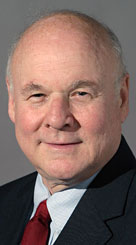For his inspired teaching of more than 4,000 students over the past 43 years,
George J. Mann, the Ronald L. Skaggs Endowed Professor in Health Facilities Design
at Texas A&M, received a special recognition award from the American Institute
of Architects-Academy of Architecture. The honor was presented by John D. Pangrazio,
AIA-AAH president, at the organization’s November 2004 conference in Washington,
D.C.
The Academy of Architecture, one of 27 AIA knowledge communities, was created
to advance knowledge and practice of quality of health-care facility design.
In the 36 year since joining the College of Architecture faculty at Texas
A&M University, Mann has spearheaded more than 400 socially significant
architecture design studio projects which have enhanced the health and welfare
of people in need around the world, while providing A&M students with unique
opportunities to gain practical, hands-on experience through “real-world” projects
yielding consequential humanitarian results.
Whether a flying ophthalmological teaching hospital or a floating critical
care facility serving third-world populations, or an ultra-modern 4.1 million
square-foot health-care institution serving a major Canadian city, Mann’s
studio projects have earned him, his students and Texas A&M University
a sterling international reputation for excellence in architecture-for-health
design and notable altruistic endeavors.
In the process, Mann has educated a new generation of highly nuanced architects
who specialize in designing smart, high-tech health-care facilities that nurture
patient recovery while facilitating the numerous and ever-changing demands
of modern medicine. Today, Mann’s former students staff health-care design
studios, and are counted among the principals of the world’s leading
architecture firms.
Throughout his teaching career, Mann has personally mentored 16 American Institute
of Architecture/American Hospital Association (AIA/AHA) Fellows; an unparalleled
achievement that has brought national and international acclaim to the A&M
architecture program.
In addition to populating the health-care design profession with compassionate
and knowledgeable practitioners, Mann’s research and scholarly pursuits
have brought new knowledge to the burgeoning field of health facilities design.
Since coming to Texas A&M, Mann has attracted more than $2 million in sponsored
research projects to the university.
In addition to being widely published in scholarly journals, he has delivered
numerous presentations at academic and professional venues around the world.
He has served as visiting professor at Columbia University, Nagoya City University,
the University of Tokyo and at Technion (the Israel Institute of Technology).
Mann’s advocacy for architecture-for-health education and modern health
facility design is unsurpassed. In 1999, with his colleague, Yasushi Nagasawa,
professor at the University of Tokyo, Mann co-founded Global University Programs
in Healthcare Architecture (GUPHA), an international organization dedicated
to the promotion of professional architecture-for-health higher education programs
and the dissemination of their research to the health design industry. The
ultimate goal of GUPHA is improved health care for the citizens of the world.
Since founded, the organization has grown from two to 25 universities.
In 2003, former president George Bush presented Mann with the Bush Excellence
in Public Service Award. In nominating Mann for the prestigious honor, Tom
Regan, dean of the Texas A&M College of Architecture, wrote: “In
a 1987, George told a newspaper reporter, ‘I like to do socially significant
projects.’ Now, 18 years and hundreds of such projects later, it is obvious
that George has been doing exactly what he likes. With no exceptions, his unwavering
pursuit for humanitarian projects has greatly benefited all parties involved.
In addition to hundreds of health facility design projects, work for the World
Health Organization and the United Nations Development Program, George’s
studios have been responsible for the design of a new worship sanctuary for
a small-town church destroyed by fire, and for a new facility to house a proposed
Brazos County African-American Museum.”
Mann’s most recent studio endeavor, in which students developed designs
for “surge” hospital facilities to aid or replace existing hospitals
in the case of overwhelming disaster, attracted the attention of U.S. Surgeon
General Richard Carmona, who participated in the projects final review.
|
|

George J. Mann
|